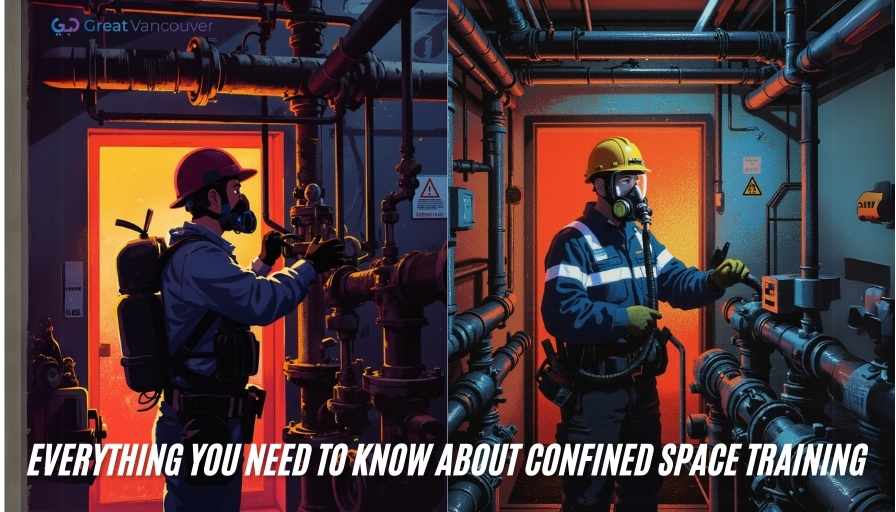Have you ever wondered what skills are necessary to paint in areas where danger lurks at every turn? If you’ve heard “Confined Space Training” you may picture a slim, claustrophobic area. You wouldn’t be wrong. But it’s more than tight quarters in those spaces. It’s about managing hidden risks. This is where limited space education will become a lifesaver!
This article will cover the whole lot about limited space education. It will explain what it is, why people need it, and how it can save lives.
What is Confined Space Training?
Confined space training teaches employees to work safely in and exit restricted areas. It teaches them to be aware of dangers, use protective gear, and respond to emergencies. Think of it as a survival kit, yet for specific painting environments.
What Qualifies as a Confined Space?
A confined area isn’t a small area. OSHA defines it as a place with capability hazards. It has restricted entry and exit and isn’t always for continuous occupancy. Examples include garage tanks, pipelines, manholes, and even certain crawl spaces in homes.
Why is confined space training necessary?
Why must you face dangers when you could prepare? Confined areas often hide risks, like poisonous gases and oxygen loss. They can also pose a threat of engulfment. Proper education enables employees to spot risks before they get harmed.
Types of Confined Space Training
Awareness Training: It’s for employees who must know the dangers of restricted areas. They do not enter them.
Entry Training: For folks who carry out obligations in constrained spaces.
Rescue Training: Designed for emergency responders who also want to rescue trapped workers.
Who Needs Confined Space Training?
If your job involves limited spaces, this schooling is for you. Employers, supervisors, employees, and emergency responders all respect knowing the dangers and protocols.
Key Elements of Confined Space Training
Hazard Identification: Recognizing risks, consisting of gas leaks or structural instability.
Equipment Use: Mastering gear, along with fuel detectors, respirators, and harnesses.
Emergency Procedures: Knowing how to act with urgency in crises.
Legal and Regulatory Requirements
Government businesses like OSHA have strict rules about limited space training. Employers have to ensure compliance to avoid penalties and to guard lives.
Common Hazards in Confined Spaces
Confined spaces can be unpredictable. Common dangers consist of:
-
Toxic gases: invisible, yet lethal threats.
-
Engulfment: Being trapped by materials that include sand or water.
-
Fires or explosions: (due to flammable materials).
Steps to Implement a Training Program
-
Assess Your Needs: Determine who needs schooling and what kind.
-
Develop Curriculum: Focus on the dangers specific to your worksite.
-
Conduct Regular Drills: Practice makes perfect!
How to Choose the Right Training Provider
Look for providers with:
-
Experienced running shoes.
-
Comprehensive programs cover OSHA guidelines.
-
Positive opinions and proven track statistics.
What Happens During Training?
Participants study through:
-
Interactive Sessions: Hands-on revelry with protective gear.
-
Simulations: Real international eventualities to check expertise.
-
Evaluations: Ensuring expertise before certification.
The Role of Rescue Plans
No one plans to fail, but failing to devise a plan may be catastrophic. Rescue plans are important in constrained space training. They detail step-by-step movements for emergencies.
Confined Space Training Costs
Costs vary depending on the intensity of schooling and the company. It may seem like an expense. It’s an investment in protection that could save lives and money.
Benefits of Regular Training Updates
Confined space regulations and technology evolve. Up-to-date schooling keeps workers organized and compliant with state-of-the-art standards.
Conclusion
Confined area education is not a compliance checkbox. It’s a dedication to protection, expertise, and employee well-being. Proper schooling meets legal necessities. It also creates a more secure environment for everyone.
FAQs
Q: What is the difference between confined space and permit-required confined space?
A permit-required confined space has extra hazards, like toxic gases or engulfment. It needs special permits and precautions.
Q: How often should confined space training be updated?
OSHA recommends annual refresher courses for any changes in hazards or procedures.
Q: What safety equipment is essential for confined spaces?
Key items include gas detectors, harnesses, respirators, and communication devices.
Q: Can confined space training be done online?
Some basic courses are online. But, hands-on training is vital for practical skills.
Q: Who is responsible for ensuring confined space safety?
Employers must provide proper training, equipment, and safety measures for their workers. It’s the law.








